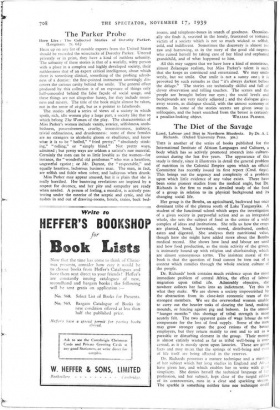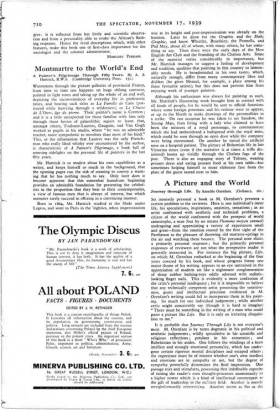The Diet of the Savage
Land, Labour and Diet in Northern Rhodesia. By Dr. A. I. Richards. (Oxford University Press. 3os.)
THIS is another of the series of books published for the International Institute of African Languages and Cultures, a body which has so actively promoted research into culture- contact during the last five years. The appearance of this study is timely, since it illustrates in detail the general problem of nutrition in the Colonial Empire upon which an official Committee has recently issued its first report (Cmd. 6o5t) This brings out the urgency and complexity of a problem upon which little evidence of any value exists. There have been some pioneer studies from the- medical angle, but Dr. Richards is the first to make a detailed study of the food of a group in relation to its physical background and its changing social life.
Her group is the Bemba, an agricultural, backward but once dominant tribe of the plateau south of Lake Tanganyika. A student of the functional school which urges the investigation of a given society in purposeful action and as an integrated whole, she sets the subject of food as the centre of a wide complex of ideas and institutions. She tells us how the crops are planted, hoed, harvested, stored, distributed, cooked, eaten and digested. She. analyses their nutritional value, though here she might have added more about the Bemba medical record. She shows how land and labour are used and how food production, as the main activity of the group, is intimately bound up with religion and chieftainship, which are almost synonymous terms. The insistent moral of the book is that the question of food cannot be torn out of a context which ramifies through the whole ancient culture of the people.
Dr. Richards' book contains much evidence upon the most immediate problem of central Africa, the effect of labour migration upon tribal life. Admirably objective, she nowhere collects her facts into an indictment. Yet this is what they make. We are shown a society impoverished by the abstraction from its close-knit economic team of the strongest members. We see the overworked women unable to carry• out the heavier tasks of clearing the land, making mounds, or fencing against pig and baboon. In the annual " hunger months " this shortage of tribal strength is most acutely felt. The two apparent gains of wage labour do not compensate for the loss of food supply. Some of the men may grow stronger upon the good rations of the better employers, but they return mainly to rest and to act as a parasitic or disturbing element in the group. Their money is almost entirely wasted as far as tribal well-being is con- cerned, as it is mostly spent upon luxuries. These are grave facts and may mean that the springs of well-being and eve" of life itself are being affected in the reserves.
Dr. Richards possesses a mature technique and a mastery of her subject which her long studies in England and Afr-i have given her, and which enables her to write with gtc't simplicity. She denies herself the technical language of her profession, and her subject, kept clear of the turgid eddies of its controversies, runs in a clear and sparkling stream. The sparkle is something neither time nor technique could
give : it is reflected from her lively and scientific observa- tion and from a personality able to evoke the African's flash- ing response. Hence the vivid descriptions which, with other features, make this book one of first-class importance for the sociologist and the colonial administrator.
MARGERY PERHAM.





































































 Previous page
Previous page